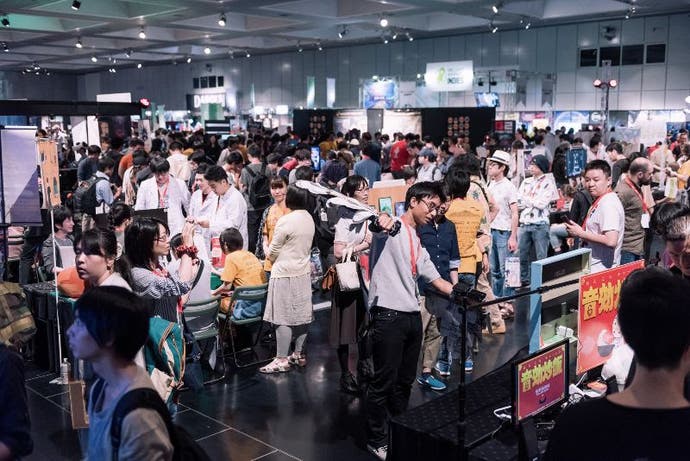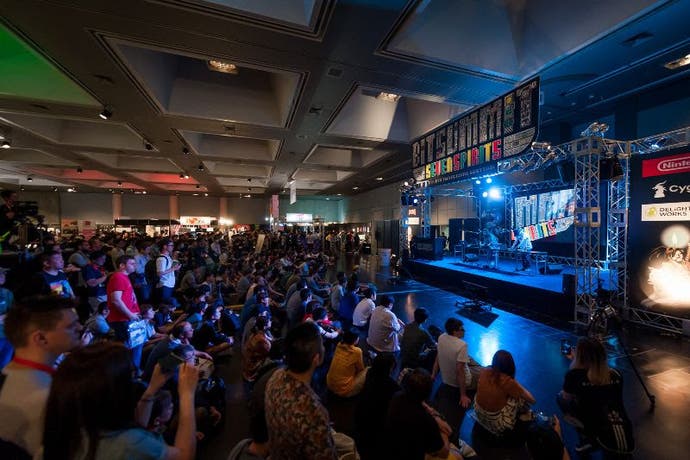BitSummit and the thrill of unearthing new games
Infinite discovery - 13 of the best from this year's show.
There was a funny notion being passed around recently that indie development had become stagnant - something which seemed all the weirder to me as I'd just finished roaming the halls of this year's BitSummit, the now well-established celebration of all things indie that takes place in the beautiful city of Kyoto.
It's one of the more vibrant shows I've had the pleasure of visiting, fitting snugly into a single hall where masses of developers assemble with their latest wares, overlooked by a small stage where a succession of acts and talks take place. Keita Takahashi talks Shuhei Yoshida through his latest offbeat creation, rapper Doseone puts in a small set while composers Keiji Yamagishi and Kaori Nakabai reunite for a live performance of the Ninja Gaiden 3 soundtrack. Familiar faces stalk the floor; Kouji Igarashi walks inquisitively from demo pod to demo pod, Q-Games' Dylan Cuthbert - a key figure behind the event - snaps away with his camera like an enthusiastic tourist, and Hideki Kamiya spends the entire show manning Platinum Games' t-shirt stall.

There are names you know, then, but really the essence of a show like this is the thrill of discovery, of stumbling upon something entirely new, and the floor is full of such delights. It feels like a disservice to only name a handful, but there's only so much you can play over a couple of days so that's exactly what I'm going to do, starting with perhaps the personal highlight of Unpacking, a gloriously soothing puzzle game that makes a virtue of tidying things away as you rifle through cardboard boxes. It's shot through with domestic detail that hints towards the lives you're organising; Tetris, with a touch of storytelling. It's sublime.
Vitei, meanwhile, brought a game that had been in development for a mere four weeks - and while you could tell as much from the rough edges, the potential for Tinker Trains is immediately apparent. It's a mechanical train-set, whereby you're purchasing new pieces of track and gadgets - balloons that'll help ferry carriages across the sky, or rockets that shunt them along with great speed - as you try and move trains from one station to another. It's a pleasantly mechanical thing governed purely by simulation, and a love for Dwarf Fortress - this is a game that's about surprising yourself by what's possible.
CyberConnect2 showed a little more of its unlikely return to the Little Bronx Tail series - with Tail Concerto and Solatorobo being the previous instalments - with Fuga, a gorgeous-looking cutesy steampunk strategy. A slightly busy description, perhaps, of what looks like a pared-back brand of strategy where the art is really allowed to sing. Just as gorgeous - and just as busy - was Star Renegade, a roguelite strategy game with its own breathtaking art-style, its pixelart mechs breathing with a sense of presence and menace. It's a game with serious chunk.

Amidst the various shmups being shown there was no shortage of chunk either. Scarlet Gazer is a mess of dot matrix distortion, like a shmup played through a fuzz pedal, while Ghostus puts an explicit puzzle spin on the genre, taking the colour-matching of the likes of Ikaruga and Radiant Silvergun and embellishing all that with more than a few ideas of its own. Blue Sabers is a more traditional take on the genre, though its love of classics such as the Raiden series serves it well.
Play Dog Play Tag might take the crown as the maddest game of this year's BitSummit, a four-player ruck which channels both Katamari Damacy and Earth Defence Force as dogs drag around their owners wrecking a flimsy cityscape in pursuit of bones. Making sense of it is half the challenge - and after that you're left with something infectiously energetic. Katamari creator Keita Takahashi's Wattam was itself looking as madcap as ever, and is hopefully drawing ever nearer to its release, while some of that eccentricity could be found in smaller projects such as the exquisite Farewell Planet, an oddity that recently released on Steam and presents an adventure with its own haunting melancholy.
BitSummit's a global affair, too, as perhaps best exemplified by Tunche - which I'm sure is the first Peruvian video game I've had the pleasure of playing. It's a 2D spin on action titles such as Bayonetta and Devil May Cry, weaving Peruvian folklore into combat that's graded by a style meter. It's energetic, enjoyable stuff.
And for all that's new and exciting, sometimes it's just as lovely to see old and familiar names return. Dotemu showed off its spin on Streets of Rage, the all-new fourth instalment complete with its divisive art-style that's perhaps a touch too smooth - though just around the corner a playable Windjammers 2 showed that same approach can work brilliantly well when its matched with the dayglo 90s palette of Data East's Neo Geo classic, and there were a handful of new tricks it's learned too.
When it comes to indies in Japan, there's perhaps no face more familiar than that of Inti Creates, here to properly unveil an all-new entry in the Gunvolt series that's due out later this year. Gunvolt Chronicles: Luminous Avenger Xi might have a title that's hard to get your head around, but it's designed as a perfect entry point to the series, and indeed to Inti Create's well-honed take on 2D action.
Away from the showfloor, Inti Creates president Takuya Aizu gave me a little insight into the landscape for independents in Japan, and what's led to the current boom in development. "For Japan, what happened in the early days, pretty much everyone was an independent developer, then some grew very very large and became corporations essentially - there were still a lot of companies, though, that stayed small, and like us became contract for hire studios. As the gap between independents and triple-a studios continued to grow and grow, the work for hire became less and less. It got to a point where they were running out of jobs to do, and running out of contract work, so those studios started to move to the mobile scene. A lot of independent developers from back in the day, they're pretty much mobile indies.
"Nowadays, with what we know as the indie scene with small companies making games, selling them digitally for the worldwide audience, that's become the norm. You're starting to see some of those older companies, older developers who'd gone all in on mobile, they're starting to come back to the console game scene because it's now viable for them to make these games that they can sell on their own.
"One of the things you can't forget - the biggest catalyst that makes this trend towards Indies you see today - is the individual developers, the doujin creators who've been selling games all on their own, selling them on Steam or what have you, or maybe on iOS, Android. Seeing such amazing, high quality games from these sometimes one-man teams, I think that's really the catalyst for what you're seeing in the Japanese indie scene. It's those doujin that have really made this possible."
BitSummit itself gave proof of what's possible, showcasing games from doujin through to bigger studios and established names, and to walk its hall was to be reinvigorated by the world of video games. Is indie development stagnant? From all I saw this last weekend, that notion couldn't be further from the truth.










